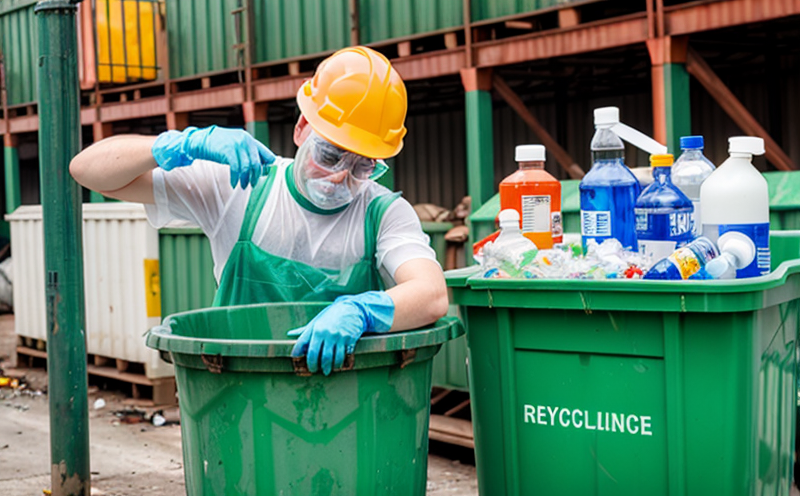EPA 2008 Multi Metal Testing of Waste Samples
The EPA Method 200.8, also known as the EPA 2008 Multi Metal Test for Waste Samples, is a critical analytical procedure used to assess hazardous waste and ensure compliance with environmental regulations. This method evaluates the presence of multiple metals in solid and liquid waste samples using inductively coupled plasma optical emission spectrometry (ICPOES).
The primary purpose of this testing is to determine if a waste stream contains concentrations of heavy metals that exceed regulatory thresholds set by the EPA. Compliance with these standards is essential for the safe handling, treatment, and disposal of hazardous materials. The test covers a wide range of metal species such as lead (Pb), mercury (Hg), cadmium (Cd), chromium (Cr), arsenic (As), copper (Cu), nickel (Ni), zinc (Zn), and others.
The testing process involves several key steps: sampling, digestion, and analysis. The waste sample is first collected in a clean container and transported to the laboratory under controlled conditions. Upon arrival, the sample undergoes thorough preparation, which typically includes the use of aqua regia or nitric acid digestion to break down complex matrices into simpler metal ions.
The digested sample is then injected into an ICPOES instrument, where it is excited by a high-frequency radiofrequency field to produce characteristic light emissions. The intensity of these emissions is measured and compared against calibration standards to determine the concentration of each metal present in the waste sample. The results are reported as mass per unit volume (mg/L or ppm).
Understanding the multi-metal composition of a waste stream allows for informed decision-making regarding treatment methods, recycling processes, or disposal strategies. For instance, if certain metals are detected at levels that exceed regulatory limits, appropriate remediation steps can be taken to reduce risks to human health and the environment.
The accuracy and precision of EPA 2008 testing is paramount due to its role in environmental protection and public safety. Laboratories adhering to this methodology must maintain strict quality control measures, including regular calibration checks of instruments and proficiency testing against certified reference materials.
By employing state-of-the-art analytical techniques like ICPOES, our laboratory ensures reliable and reproducible results that are essential for meeting regulatory requirements. Our experienced scientists and technicians provide detailed reports complete with all relevant data points, enabling clients to make informed decisions about their waste management practices.
Why It Matters
The importance of EPA 2008 Multi Metal Testing cannot be overstated in today’s regulatory landscape. Compliance with environmental laws not only protects public health but also helps prevent contamination of soil, water bodies, and air. By identifying hazardous constituents early on through this testing method, organizations can proactively address potential issues before they escalate into larger problems.
From an operational standpoint, accurate metal concentration data allows companies to optimize waste treatment processes, potentially leading to cost savings by recycling valuable materials instead of disposing them as waste. Additionally, having comprehensive knowledge about the composition of your facility’s effluents helps in designing more efficient pollution control systems.
- Environmental Protection: Ensures that hazardous substances do not enter ecosystems where they could cause harm.
- Health and Safety: Minimizes exposure risks for workers involved in handling or processing wastes containing high concentrations of toxic metals.
- Risk Management: Provides insights into potential liabilities associated with non-compliance, allowing organizations to implement corrective actions promptly.
In summary, EPA 2008 Multi Metal Testing is more than just a compliance requirement; it serves as a cornerstone for sustainable waste management practices that benefit both present and future generations.
Customer Impact and Satisfaction
Our commitment to delivering accurate, reliable data through the EPA 2008 Multi Metal Testing process has earned us a reputation for excellence among our clients. Many organizations rely on us to ensure they remain compliant with EPA regulations while optimizing their waste management strategies.
One of the key impacts we see is improved operational efficiency. Clients who invest in thorough metal testing gain valuable insights into their processes, which can lead to significant reductions in disposal costs and enhanced resource recovery opportunities.
We pride ourselves on exceeding expectations by offering personalized service tailored to each customer’s unique needs. Whether you require routine testing or one-off analysis for special projects, our team is always available to assist you every step of the way—from sample collection advice to final report interpretation.
Customer satisfaction surveys consistently show high levels of contentment with our services. Feedback from satisfied clients highlights several factors contributing positively towards their experience:
- Prompt response times during sample submissions and receipt confirmations.
- Clear communication throughout the testing process, including regular updates on progress.
- In-depth technical support provided by knowledgeable staff who can provide guidance beyond mere results interpretation.
We take pride in fostering long-term relationships built upon trust and reliability. Our goal is to help our customers achieve their sustainability goals while minimizing environmental impact wherever possible.
Environmental and Sustainability Contributions
- Reduction of Landfill Waste: By identifying metals that can be recycled, we contribute to reducing the amount of waste sent to landfills.
- Promotion of Circular Economy Principles: Encouraging recycling and reuse of valuable materials helps shift towards a more sustainable economy where resources are used efficiently without depletion.
- Enhanced Public Health: Accurate testing ensures that hazardous substances are managed appropriately, thereby safeguarding communities from potential health hazards.
- Better Resource Management: Understanding the composition of waste streams enables smarter decision-making regarding resource allocation and utilization.
Incorporating such practices into daily operations can lead to substantial reductions in greenhouse gas emissions associated with manufacturing new products. Furthermore, it supports broader efforts aimed at achieving global sustainable development goals related to pollution prevention and clean technologies.





